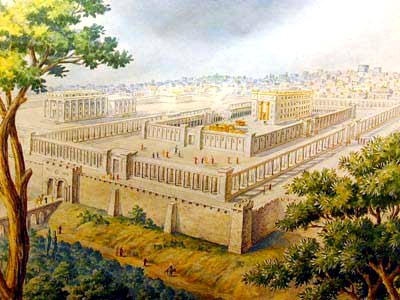 The Book of Ezekiel’s final nine chapters are among the most fascinating in all of Scripture. Despite this, they are all too often ignored by the majority of Christians. One of the reasons for this is that many students of Scripture simply do not know what to make of what they are reading. For the chapters describe an astonishing temple, producing wonders, that has not yet come into existence. Additionally, the temple is used for animal sacrifices; something that has apparently been done away with. However, Ezekiel is surely a true prophet and thus his prophecies must come to pass in every detail just as described (cf. Duet. 18:20-22). Therefore, we can be assured that a new temple is yet to be built matching the one foreseen by the prophet. It will not be constructed until after Jesus returns to set up His kingdom. And yet, there will be no temple in the Eternal State (Rev. 21:22). We can then rightly infer that Ezekiel’s temple is a messianic millennial temple.
The Book of Ezekiel’s final nine chapters are among the most fascinating in all of Scripture. Despite this, they are all too often ignored by the majority of Christians. One of the reasons for this is that many students of Scripture simply do not know what to make of what they are reading. For the chapters describe an astonishing temple, producing wonders, that has not yet come into existence. Additionally, the temple is used for animal sacrifices; something that has apparently been done away with. However, Ezekiel is surely a true prophet and thus his prophecies must come to pass in every detail just as described (cf. Duet. 18:20-22). Therefore, we can be assured that a new temple is yet to be built matching the one foreseen by the prophet. It will not be constructed until after Jesus returns to set up His kingdom. And yet, there will be no temple in the Eternal State (Rev. 21:22). We can then rightly infer that Ezekiel’s temple is a messianic millennial temple.
THE MESSIAH’S HOUSE
Though the details of this temple are in his final chapters, the prophet previously foretold of its arrival in Ezekiel 37:26-28:
I will make a covenant of peace with them. It shall be an everlasting covenant with them. And I will set them in their land and multiply them, and will set my sanctuary in their midst forevermore. My dwelling place shall be with them, and I will be their God, and they shall be my people. Then the nations will know that I am the LORD who sanctifies Israel, when my sanctuary is in their midst forevermore.
Once Israel is brought into the New Covenant they will be in an obedient relationship with God and thus dwell safely in the Promised Land (v. 26). This allows for the ideal temple to finally arise, for the LORD requires His own house (v. 27). Among all the reasons in the Millennium for the nations to be aware of the fact that the God of Israel is the LORD, the temple is specifically mentioned as a cause (v. 28).
HER CONSTRUCTION
One of the reasons for the nations’ keen awareness of the temple will be due to Gentiles having the honor of helping Jesus construct it. Once the passages that cover this are considered, the final chapters of Ezekiel become a simple matter to understand. Zechariah 6:12-14 and 6:15:
And say to him, “Thus says the LORD of hosts, “Behold, the man whose name is the Branch: for he shall branch out from his place and he shall build the temple of the LORD. It is he who shall build the temple of the LORD and shall bear royal honor, and shall sit and rule on his throne. And there shall be a priest on his throne, and the counsel of peace shall be between them both.”’
And to those who are far off shall come and help build the temple of the LORD. And you shall know that the LORD of hosts has sent me to you. And this shall come to pass, if you will diligently obey the voice of the LORD your God.”
After the Jewish people returned from the Babylonian captivity they began to rebuild the temple under the oversight of Zerubbabel the governor and Joshua the high priest. Zechariah took the opportunity to use the construction of the second temple as an object lesson on the future coming of the Messiah and the temple that He will build. That the prophet is ultimately looking toward the Messiah is made clear with his reference to Branch (v. 12), a title belonging to the Messiah in relation to Him ruling from David’s throne (e.g. Jer. 23:5; 33:15). It is repeated that the Branch will build the temple of the LORD and rule from His throne. The Branch will enjoy both the offices of king and priest (v. 13), further cementing that the Messiah will fulfill the prophet’s words (cf. Gen. 14:18; Heb. 5:10). Those who live far away from the land of Israel will come to aid in building the temple (v. 15). The Gentiles will bring the wealth of their nations, filling the temple (Hag. 2:7). They will be brought to the holy mountain to enjoy equal access to the sanctuary and find joy within. In that day the temple will be called a house of prayer for all peoples (Is. 56:7).
SHILOH
As Ezekiel was taken to the very high mountain in the land of Israel, he could see that Jerusalem was on the south side of the fifty square mile summit (Ezek. 40:2; cf. Ezek. 48:8). This suggests that the prophet was coming in from the north, which is where his tour of the temple would soon commence. This places the temple in the Shiloh area, approximately twenty-seven miles north of Jerusalem. Shiloh being on the summit includes it as part of the overall holy district, separated from the world along with Jerusalem. Messiah’s temple being in Shiloh instead of where the first and second temples sat is more than just a matter of requiring sufficient space. God said that Shiloh was the place where He made His name to dwell at the first (Jer. 7:12). The Tabernacle often rested in Shiloh from about 1375 B.C. (Jos. 18:1) until it was evidently razed by the Philistines after they captured the Ark of the Covenant in 1050 B.C. (1 Sam. 5:1). The Tabernacle was the portable home for the glory of the LORD, making it a proto-temple in its own right. The LORD, through movement of His glory, would determine where the Tabernacle was be erected (Ex. 40:35-38; cf. Deut. 12:11). This makes Shiloh God’s personal choice as His once and future home among His people.
The temple in Shiloh is connected, to a lesser or greater extent, to a key messianic prophecy in Genesis 49:10. Jacob blessed Judah by proclaiming that the right of kingship would never depart from his line nor would the lawgiver cease until Shiloh comes, and to him will be the obedience of the nations. The meaning of Shiloh as used in this verse is uncertain. Some take it as a title for the Messiah, while others understand it as a possessive pronoun, meaning whose it is. The problem phrase could also be translated as until he comes to Shiloh. If the last option is correct then this well-known passage not only prophesies the Lion from the tribe of Judah as King over all the nations, but even tells us where His house will be.

Good article. I long to see this beautiful temple.
Thank you sir.
Well, here I am, in 2022, Reading this. Helped me a por. Thank you and Good bless you.